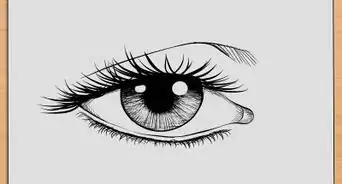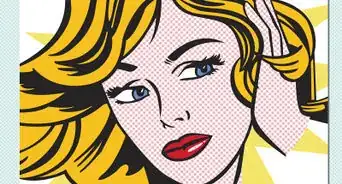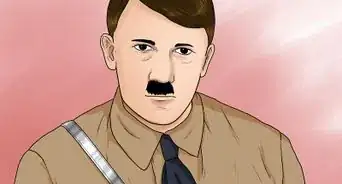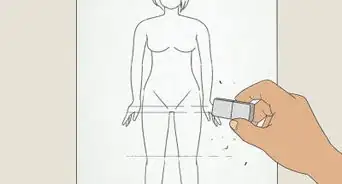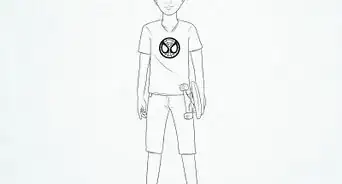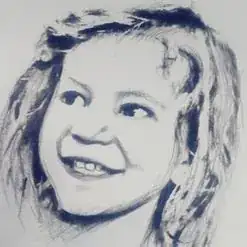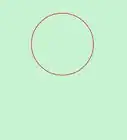This article was co-authored by Claire Wentzel. Claire Wentzel is an award-winning Artist and Strategic Creative Consultant. Her business, Red Rose Studios, is based in Las Vegas, Nevada, where she also serves on the Clark County Public Art Committee. With over 20 years of experience, she specializes in mixed media participatory art, brand messaging, and building organizational culture. She earned her BA in Fine Art with Distinction from the University of Colorado-Boulder and completed a painting residency at the International School of Painting, Drawing, and Sculpture. Her chalk mural work has been featured in EdHat and I Madonnari Italian Street Painting Festival advertising.
wikiHow marks an article as reader-approved once it receives enough positive feedback. In this case, several readers have written to tell us that this article was helpful to them, earning it our reader-approved status.
This article has been viewed 1,926,483 times.
Since the earliest times, humans have spent a great deal of time trying to capture the essence of the human face. This can be enjoyable, but it's better if you know how. While our bodies add dynamism to artworks, the face is filled with expression—the very soul of our being. Learning to bring that out starts with learning how to draw a basic human face. Where you take it next will be in your charcoal- or paint-stained fingers.
Steps
-
1Draw an oval slightly wider at the top than bottom. Lightly sketch a vertical line down the center, then draw a horizontal line halfway between the top and bottom of the oval. This line will give you the eye placement. Divide the remaining space below in half and make a line there. This will be for the base of the average-length nose. Divide the space below that into thirds. The mouth will be at the top of those thirds; the rest will be the chin.
-
2On the middle horizontal line, draw two almond shapes - these are the eyes. On an anatomically correct face, five eyes fit across the span of the face, with the length of an eye fitting in between the two that will be drawn. Starting from the left, the eyes we want are the second and fourth. The inner corner of most eyes tilts down; the outer corner can tilt up or down, depending. For our purposes, that outside corner should tilt up a bit, so that the line that describes the bottom lid looks like a very slight "s" shape on its side.Advertisement
-
3Down the center line, draw a nose. The nose is narrowest between the eyes and widest at the nostrils. Notice how the tip turns under. Everyone's nose is unique, and if you are doing a portrait, capturing someone's nose exactly will give your drawing more authority.
-
4Go back up to the top horizontal line. On either side of this, draw ears. Notice that the ears stick out wider at the top and then come in near the lobes. Some lobes are attached and some are loose. Ears are pretty complicated to draw - keep them simple at first until you get an idea of their construction.
-
5Add a mouth. Make a flat, rounded "V" shape that is dips below the lowest line. That will be the bottom of the lower lip. Join that smile line with a wide, soft "M" shape—the top of the upper lip. Draw a very soft "m" shape between the two, which defines the separation of the lips, and the lip ratio. Moving the mouth up or down, and making the top and bottom lips with different proportions will help vary the look of the face you're drawing.
-
6Drawing the hair. Hair is hard to draw, but start off with lines (remember, this is line drawing). Is the hair straight? Parallel lines curving around the head. Is the hair curly? Curved lines. Notice how curly hair breaks into clumps composed of parallel strands.
-
7Finish with the neck. The neck is thicker than we like to think. The sides start at the top of the jaw line and go down on a curve.
-
8Add a collar or neckline of some sort. You can add a shirt, jacket, turtleneck—even nothing at all. The type of clothing you add will give your drawing some sense of time and place.
-
9Finished.
Expert Q&A
-
QuestionHow can I make my portraits look more realistic?
 Renée PlevyRenée Plevy is an Internationally Acclaimed Portrait Artist from New York/Palm Beach who has painted The Grand Dames of Palm Beach and various celebrities and community leaders. With over 50 years of experience, Renée specializes in painting realistically in oil and capturing the soul of the person. She has studied under internationally renowned portrait artists John Howard Sanden, David Leffel, Robert Beverly Hale, Clyde Smith, and Leonid Gervits. Renée is featured in over 68 shows and galleries including a one-woman museum show at the Paterson Museum. She has garnered numerous awards including “Artist of the Year” from The Bloomfield Art League and First Prize from the Boca Raton Museum Artist’s Guild. Renée has even painted a portrait of celebrity, Vanilla Ice. She also teaches at the Boca Raton Museum Art School - formerly at SVA in Manhattan.
Renée PlevyRenée Plevy is an Internationally Acclaimed Portrait Artist from New York/Palm Beach who has painted The Grand Dames of Palm Beach and various celebrities and community leaders. With over 50 years of experience, Renée specializes in painting realistically in oil and capturing the soul of the person. She has studied under internationally renowned portrait artists John Howard Sanden, David Leffel, Robert Beverly Hale, Clyde Smith, and Leonid Gervits. Renée is featured in over 68 shows and galleries including a one-woman museum show at the Paterson Museum. She has garnered numerous awards including “Artist of the Year” from The Bloomfield Art League and First Prize from the Boca Raton Museum Artist’s Guild. Renée has even painted a portrait of celebrity, Vanilla Ice. She also teaches at the Boca Raton Museum Art School - formerly at SVA in Manhattan.
Portrait Artist & Educator One of the top mistakes people make is they make the person look like they are on eye level, like you're looking directly into someone's eyes. It's better to draw the person as if they have bent their head down, or moved it to the right or the left, or are shorter than the artist or taller than them. Try to look in a magazine to find a photograph of somebody that actually has their face eye level with the person who they were speaking to... It's not natural, and it took me a good two hours!
One of the top mistakes people make is they make the person look like they are on eye level, like you're looking directly into someone's eyes. It's better to draw the person as if they have bent their head down, or moved it to the right or the left, or are shorter than the artist or taller than them. Try to look in a magazine to find a photograph of somebody that actually has their face eye level with the person who they were speaking to... It's not natural, and it took me a good two hours! -
QuestionHow do you get better at drawing faces?
 Renée PlevyRenée Plevy is an Internationally Acclaimed Portrait Artist from New York/Palm Beach who has painted The Grand Dames of Palm Beach and various celebrities and community leaders. With over 50 years of experience, Renée specializes in painting realistically in oil and capturing the soul of the person. She has studied under internationally renowned portrait artists John Howard Sanden, David Leffel, Robert Beverly Hale, Clyde Smith, and Leonid Gervits. Renée is featured in over 68 shows and galleries including a one-woman museum show at the Paterson Museum. She has garnered numerous awards including “Artist of the Year” from The Bloomfield Art League and First Prize from the Boca Raton Museum Artist’s Guild. Renée has even painted a portrait of celebrity, Vanilla Ice. She also teaches at the Boca Raton Museum Art School - formerly at SVA in Manhattan.
Renée PlevyRenée Plevy is an Internationally Acclaimed Portrait Artist from New York/Palm Beach who has painted The Grand Dames of Palm Beach and various celebrities and community leaders. With over 50 years of experience, Renée specializes in painting realistically in oil and capturing the soul of the person. She has studied under internationally renowned portrait artists John Howard Sanden, David Leffel, Robert Beverly Hale, Clyde Smith, and Leonid Gervits. Renée is featured in over 68 shows and galleries including a one-woman museum show at the Paterson Museum. She has garnered numerous awards including “Artist of the Year” from The Bloomfield Art League and First Prize from the Boca Raton Museum Artist’s Guild. Renée has even painted a portrait of celebrity, Vanilla Ice. She also teaches at the Boca Raton Museum Art School - formerly at SVA in Manhattan.
Portrait Artist & Educator It can really help to find a good art teacher in your area, as they can help you see what you're missing. We have a tendency to not actually see what's in front of us—you have to develop an artist's eye first. An art teacher can help you see more than you've seen in the past, whether you're looking at an object or a person.
It can really help to find a good art teacher in your area, as they can help you see what you're missing. We have a tendency to not actually see what's in front of us—you have to develop an artist's eye first. An art teacher can help you see more than you've seen in the past, whether you're looking at an object or a person. -
QuestionHow do you get better at drawing faces?
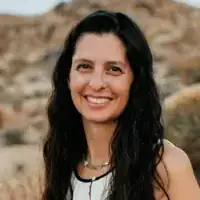 Claire WentzelClaire Wentzel is an award-winning Artist and Strategic Creative Consultant. Her business, Red Rose Studios, is based in Las Vegas, Nevada, where she also serves on the Clark County Public Art Committee. With over 20 years of experience, she specializes in mixed media participatory art, brand messaging, and building organizational culture. She earned her BA in Fine Art with Distinction from the University of Colorado-Boulder and completed a painting residency at the International School of Painting, Drawing, and Sculpture. Her chalk mural work has been featured in EdHat and I Madonnari Italian Street Painting Festival advertising.
Claire WentzelClaire Wentzel is an award-winning Artist and Strategic Creative Consultant. Her business, Red Rose Studios, is based in Las Vegas, Nevada, where she also serves on the Clark County Public Art Committee. With over 20 years of experience, she specializes in mixed media participatory art, brand messaging, and building organizational culture. She earned her BA in Fine Art with Distinction from the University of Colorado-Boulder and completed a painting residency at the International School of Painting, Drawing, and Sculpture. Her chalk mural work has been featured in EdHat and I Madonnari Italian Street Painting Festival advertising.
Award-Winning Artist and Strategic Creative Consultant Look at them. My favorite technique that I learned for drawing anything, but especially as a good technique to draw portraits, is blind contour drawing. This is an exercise where you look at your subject and you cannot look at your paper or lift up your pencil while you draw. You are training your eye to talk to your hand. This is a fundamental skill that really helps with drawing portraiture in particular.
Look at them. My favorite technique that I learned for drawing anything, but especially as a good technique to draw portraits, is blind contour drawing. This is an exercise where you look at your subject and you cannot look at your paper or lift up your pencil while you draw. You are training your eye to talk to your hand. This is a fundamental skill that really helps with drawing portraiture in particular.
Warnings
- Drawings often do not come out perfect the first time. Remember to have patience with yourself and never stop.⧼thumbs_response⧽
- Make sure you have a sharpened pencil. A dull pencil is really hard to draw with and makes your pictures look very messy.⧼thumbs_response⧽
- Make sure to take small breaks here and there so your hands do not get sweaty and you have proper grip towards the pencil as well as clean and visible face features!⧼thumbs_response⧽
Things You'll Need
- Paper, pencil and eraser - preferably a grey kneaded eraser.
-
Tracing Paper, or a Tracing Box. If you don't have one, you can put a light under a glass table.
- Color or texture pencils.
- Different types of pencils; Light, Moderate, Heavy, Shading, etc. Go to any art supply shop and ask for HB, 2B & 6B pencils. These three should be good for any sketches that you want to make
- A reference image is helpful if you are not drawing from a model.
- As a beginner, realize that it is possible to create beautiful and stunning face with a standard #2 pencil and eraser. However, realize different types of pencils can help to accentuate your art by creating finer detail and contrast.
References
About This Article
To draw a human face, start by drawing an oval that's a little bit wider at the top. Then, divide the oval in half both ways by drawing a horizontal and vertical line. Next, draw 2 almond shapes on the horizontal line to make the eyes, and draw a nose so the bottom of the nose is halfway between the eyes and the chin. Once you've drawn the eyes and nose, add a mouth halfway between the nose and chin. Finally, add in the finishing touches, like ears, eyebrows, and hair. To learn how to draw pupils inside the eyes on the face you drew, scroll down!
